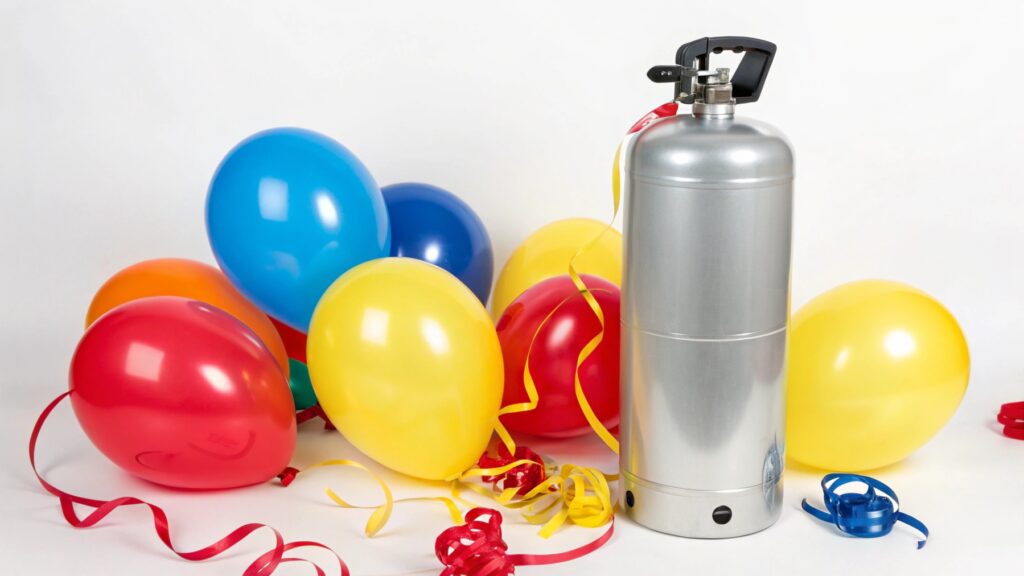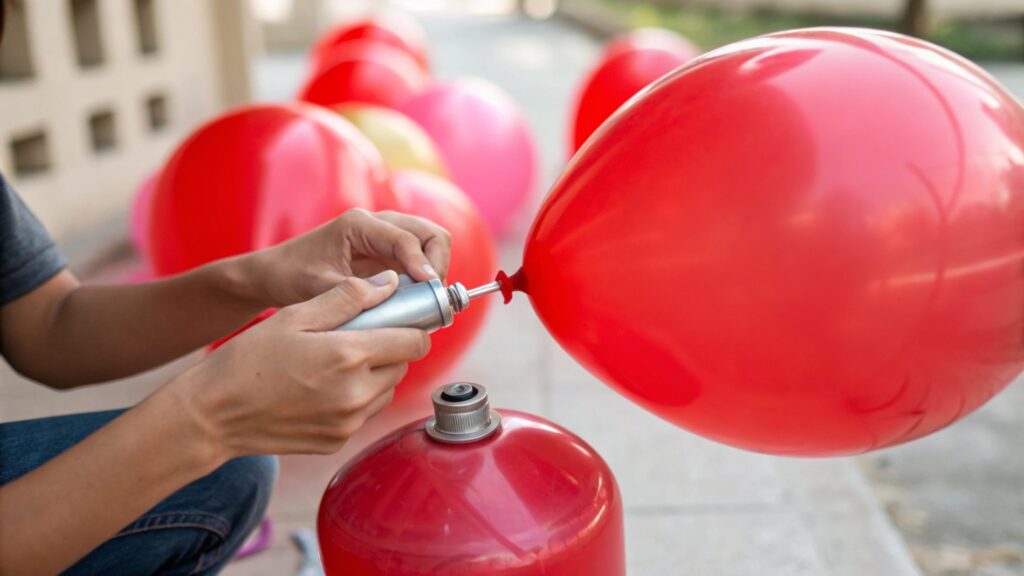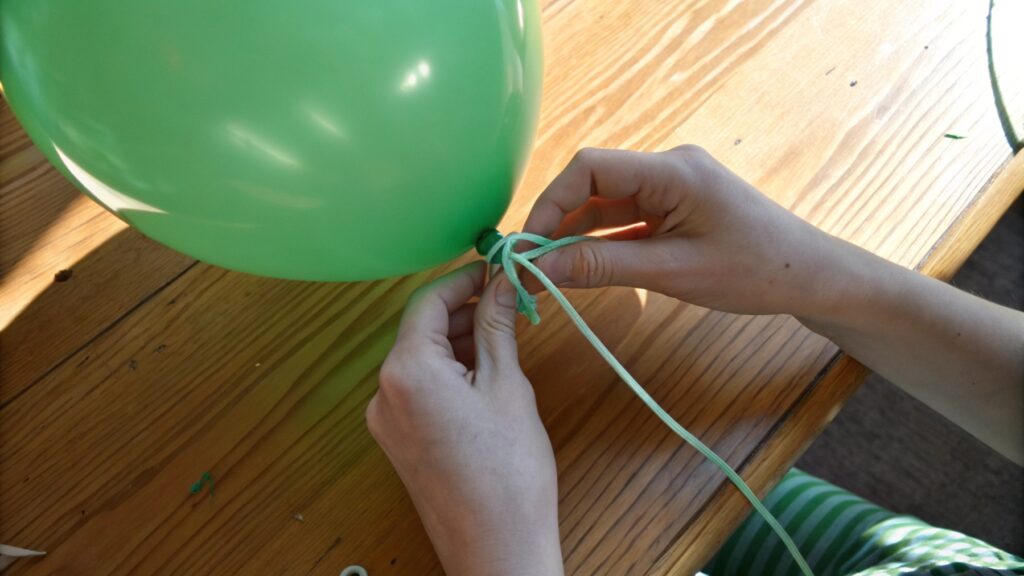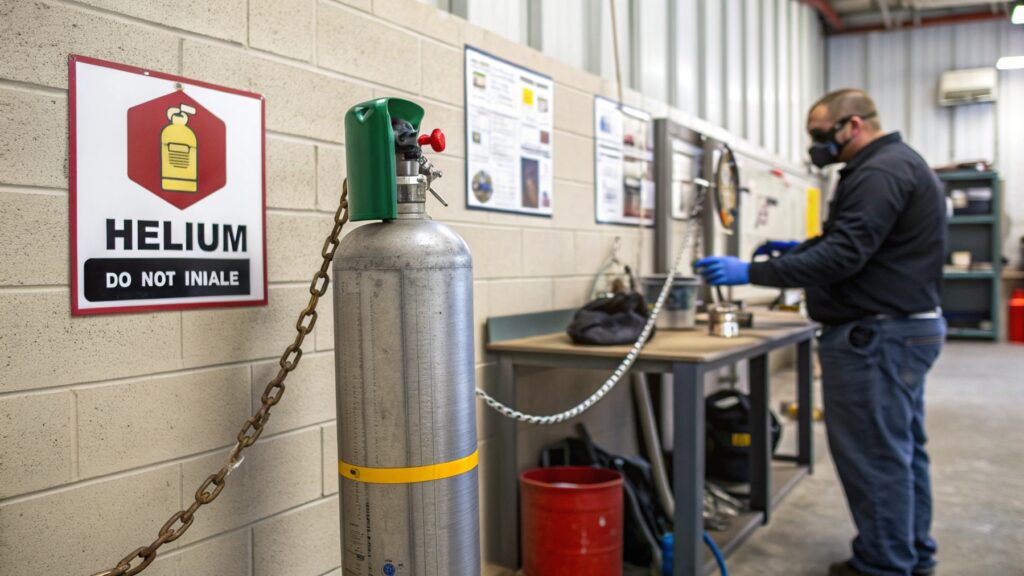How Can You Inflate and Seal a Latex Party Balloon (Helium)?
Are you struggling to get your latex balloons perfectly inflated and sealed for your next event? Many people find this tricky, leading to deflated balloons or wasted helium.
Inflating and sealing a latex balloon with helium typically involves using a helium tank1 with a nozzle to fill the balloon, followed by manually tying the balloon's neck or using a balloon-tying tool2 to prevent air from escaping. Proper technique ensures longer float times and a better display.

I have seen many people frustrated when their party balloons don't float or deflate too quickly. Let me walk you through the proper way to handle them.
What Are the Best Methods to Inflate a Latex Balloon With Helium?
Are you wondering how to get that perfect float for your latex balloons? Getting enough helium in without popping them can be a challenge.
The best method to inflate a latex balloon with helium3 is to use a helium tank equipped with a proper inflation nozzle4, ensuring a slow, controlled fill until the balloon reaches its desired size and shape without overfilling.

When I first started in this industry, I quickly learned that inflating balloons is an art. It is not just about filling them with gas. It is about understanding the material and getting it just right.
Choosing the Right Nozzle
Using the correct nozzle is key. Different nozzles help control the gas flow. This control prevents the balloon from popping.
Proper Inflation Technique5
To inflate a balloon, place the balloon's neck over the nozzle. Hold the neck tightly around the nozzle. Press the nozzle down to release helium. Fill the balloon until it is firm but still pliable. Do not overfill. An overfilled balloon will pop or lose helium faster.
| Nozzle Type6 | Description | Best Use |
|---|---|---|
| Push-valve Nozzle | Manual control, helium flows when pressed. | Standard latex balloons, good control. |
| Tilt-valve Nozzle | Helium flows when valve is tilted. | Larger balloons, hands-free options. |
| Automatic Shut-off | Stops filling when balloon reaches a set pressure. | High volume, prevents over-inflation. |
My Personal Experience
I have seen many balloons pop from overfilling. It is always better to slightly underfill than to overfill. A slightly softer balloon will last longer than one filled to its absolute limit. Overfilling puts too much stress on the latex. This stress causes microscopic holes. These holes allow helium to escape faster.
How Do I Properly Seal a Latex Balloon After Helium Inflation?
Do your balloons always seem to lose air shortly after you inflate them? Sealing them correctly is often the problem.
To properly seal a latex balloon after helium inflation, you must firmly tie the neck of the balloon into a knot as close to the balloon's body as possible, ensuring no air can escape through the opening.

I have seen countless balloons deflate because they were not tied correctly. A good seal is as important as the inflation itself.
The Manual Knot Method
The most common way to seal a latex balloon is by tying a knot by hand. You gather the neck of the balloon. Then you wrap it around two fingers. You pull the end through the loop. This creates a secure knot. Make sure the knot is tight against the balloon's base. This prevents helium from leaking.
Using a Balloon Tying Tool
For those who tie many balloons or find manual tying difficult, a balloon-tying tool can help. This tool makes the process easier and faster. It also saves your fingers from getting sore. I have seen many people struggle with sore fingers after tying hundreds of balloons. This is especially true with lower-quality latex balloons. These balloons can be stiffer and harder to tie. Good quality latex balloons are softer and easier on the hands.
| Sealing Method | Pros | Cons |
|---|---|---|
| Manual Hand Knot | Secure, no extra tools needed, cost-effective. | Can be hard on fingers, slower for many. |
| Balloon Tying Tool | Faster, saves fingers, consistent knots. | Requires an extra tool, some learning. |
My Personal Experience
I prefer tying knots by hand when possible. It feels more direct. But I always recommend buying high-quality latex balloons. They are softer and much easier to tie. This makes a big difference. Cheaper balloons can hurt your fingers. They are harder to knot securely. For large events, a tying tool can be a lifesaver. But for a few balloons, hands work best for me.
What Safety Practices Should I Follow When Filling Balloons With Helium?
Are you worried about safety when handling helium? It is an inert gas, but it needs to be handled with care.
When filling balloons with helium, always ensure the area is well-ventilated to prevent dizziness from inhaling helium. Secure helium tanks to prevent tipping, and never intentionally inhale helium, as it can displace oxygen and cause serious health risks.

I always stress safety in our operations. Handling any gas, even an inert one like helium, needs caution.
Ventilation and Tank Stability
Always work in a well-ventilated area. Helium displaces oxygen. Breathing too much helium can cause dizziness. It can also lead to fainting. Secure your helium tank. Use a tank cart or chain it to a wall. This prevents it from falling over. A falling tank can cause serious injury or damage.
Never Inhale Helium
It may seem fun to talk in a squeaky voice after inhaling helium. But this is very dangerous. Inhaling helium deprives your body of oxygen. This can lead to loss of consciousness. It can also cause brain damage or even death. Always keep helium away from your mouth and nose.
| Safety Practice | Reason | Consequence of Neglect |
|---|---|---|
| Good Ventilation7 | Prevents oxygen displacement, avoids dizziness. | Dizziness, fainting, shortness of breath. |
| Secure Helium Tank8 | Prevents tipping, avoids injury or damage. | Physical injury, property damage. |
| Do Not Inhale Helium9 | Prevents oxygen deprivation, protects brain. | Loss of consciousness, brain damage, death. |
| Proper Nozzle Use | Controls gas flow, prevents balloon bursting. | Balloon shrapnel, wasted helium. |
My Personal Experience
I have seen incidents where people got lightheaded from poor ventilation. I also heard about accidents from unsecured tanks. These experiences reinforced the importance of safety protocols. We always train our staff thoroughly. We ensure they follow all safety guidelines. It is not just about company policy. It is about protecting people.
How Long Will a Latex Balloon Stay Inflated After Being Filled With Helium?
Are you curious about how long your party decorations will last? The lifespan of a helium-filled latex balloon can vary a lot.
A standard latex balloon filled with helium typically floats for 8 to 12 hours. Factors like balloon size, quality of latex, environmental conditions, and proper sealing can significantly affect its float time, sometimes shortening it to only a few hours or extending it slightly.

I often get asked how long balloons will last. It is a common question. The answer depends on several factors.
Factors Affecting Float Time
Several things influence how long a latex balloon stays inflated.
Size of the Balloon
Larger balloons float longer. A bigger balloon holds more helium. It also has a smaller surface area to volume ratio. This means helium escapes slower.
Quality of the Latex
High-quality latex balloons have thicker walls. They also have fewer pores. This makes them less permeable to helium. Our AIHUA BALLOON products are designed for longer float time10s. They use premium latex.
Environmental Conditions
Temperature and humidity play a role. Cold air makes balloons shrink. Warm air makes them expand. High humidity can also affect the latex.
Proper Sealing
A well-tied knot prevents helium leakage. A loose knot can cause the balloon to deflate quickly.
| Factor | Impact on Float Time | Explanation |
|---|---|---|
| Balloon Size | Larger = Longer Float Time | More helium, less relative surface area for escape. |
| Latex Quality | Higher Quality = Longer Float | Thicker walls, fewer pores, less permeable. |
| Temperature | Extreme = Shorter Float | Cold shrinks, heat expands, stressing latex. |
| Humidity | High Humidity = Shorter Float | Moisture can affect latex permeability. |
| Sealing Technique | Proper Seal = Longer Float | Prevents helium leakage from the knot. |
My Personal Experience
I have seen cheap balloons deflate in just a few hours. This is even if they were handled perfectly. But a good quality balloon can easily last for over 12 hours. Sometimes they last even longer. We at AIHUA BALLOON focus on quality. We want your moments to stay colorful for as long as possible. We test our balloons. We ensure they meet international safety standards. This gives our customers confidence in our products.
Conclusion
Inflating and sealing latex balloons with helium requires proper technique and adherence to safety guidelines. Using good quality balloons and following the right steps ensures your decorations last longer and look great.
-
Learn how to effectively use a helium tank for balloons to avoid waste and ensure proper inflation. ↩
-
Discover the benefits of using a balloon-tying tool for quick and secure balloon sealing at your next event. ↩
-
Explore this link to learn expert tips and techniques for inflating latex balloons with helium effectively, ensuring they float perfectly! ↩
-
Find out why using a proper inflation nozzle is crucial for balloon inflation and how it can prevent common issues like popping. ↩
-
Understanding the proper inflation technique is crucial for ensuring balloons last longer and perform better. Explore this resource for expert tips! ↩
-
Learning about different nozzle types can enhance your balloon inflation skills and prevent mishaps. Check out this link for detailed information! ↩
-
Understanding the importance of good ventilation can help prevent serious health risks when handling helium. Explore this link for detailed insights. ↩
-
Learn effective methods to secure helium tanks and avoid potential injuries or damages. This resource provides essential safety tips. ↩
-
Discover the serious health risks associated with inhaling helium and why it's crucial to avoid this practice. This link offers vital information. ↩
-
Understanding float time is crucial for planning events. Explore this link to learn how to maximize balloon longevity. ↩
